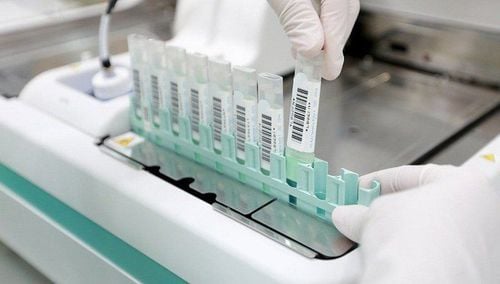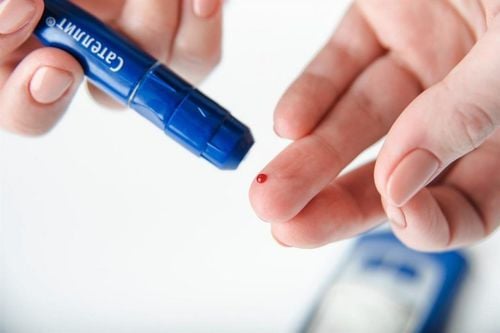This is an automatically translated article.
Blood lactate test is one of the highly appreciated tests in monitoring and diagnosing many diseases, especially for patients in emergency resuscitation.1. What is a blood lactate test?
Blood lactate test is a test method conducted to measure the amount of lactate in the patient's blood, in rare cases in the cerebrospinal fluid.
Lactate is a product created during cellular metabolism. Sometimes lactate can appear as lactic acid depending on the pH. However, the human body has a neutral pH, so it usually appears in the blood as lactate.
In normal people, the concentration of lactate in the blood and in the cerebrospinal fluid is usually low. It is only when cells do not have enough oxygen or when the energy-producing pathways in cells are disrupted that red blood cells, muscle cells, brain and other tissues produce excessive amounts of lactate. .
When a person has a marked increase in blood lactic acid levels (or lactate) that can progress to lactic acidosis. Severe lactic acidosis can disrupt the balance of acids and bases, causing symptoms such as nausea, vomiting, sweating, and even coma.

Xét nghiệm lactate máu
Therefore, doing a blood lactate test can help control hyperlactate levels in the blood and take timely intervention.
2. Causes of increased blood lactate
There are many causes leading to hyperlactatemia, however, based on the mechanism causing lactic acidosis, these causes can be divided into 2 main groups.
Most common is lactic acidosis type A due to inadequate oxygen uptake or tissue hypoperfusion due to reduced blood flow, eg:
Heart attack Infection, congestive heart failure Pulmonary disease or severe respiratory failure Pulmonary edema Severe anemia Shock due to extreme blood loss or trauma

Đau tim có thể là nguyên nhân dẫn đến tăng lactate máu
The second group is lactic acidosis type B , which is caused by excessive oxygen demand or problems related to metabolism:
Liver and kidney disease Uncontrolled diabetes Glycogen storage disease (eg. Glucose-6-Phosphatase deficiency) Leukemia AIDS Certain drugs or toxins such as cyanide, methyl, salicylates,... Inherited mitochondrial and metabolic diseases such as muscular dystrophy High intensity exercise such as athletes
3. Indication for blood lactate test
Usually, a patient is ordered to have a blood lactate test if one of the following symptoms occurs:
Shortness of breath or rapid breathing Nausea Pale, pale body Sweating Unexplained abdominal pain Muscle weakness People in a coma Suspected cases of sepsis, heart attack, severe congestive heart failure, kidney failure or uncontrolled diabetes.

Người bệnh xuất hiện triệu chứng buồn nôn
Initially, to assess the general condition of each person, a blood lactate test will be ordered in combination with a number of other tests. In cases of significant elevation, blood lactate testing will be repeated at regular intervals to monitor disease status.
4. What disease does a blood lactate test help diagnose?
Blood lactate test is of high value in diagnosing metabolic infections:
Hyperlactatemia: lactic acid levels in the blood increase but there is no change in blood pH. Lactic acidosis (hyperlactacidemia): increased lactic acid levels in the blood (above 7mmol/L) combined with a decrease in blood pH. In addition, blood lactate testing is also useful in finding and determining the cause of metabolic acidosis and increased anion gap:
Secondary lactic acidosis (type A lactic acidosis due to hypoxia): septic shock, cardiogenic or hypovolemic,... Primary lactic acidosis (type B lactic acidosis not accompanied by tissue hypoxia): suggestive of an etiology of liver failure, chronic renal failure, substance poisoning such as ethanol, salicylate or congenital enzyme deficiency.
In particular, blood lactate test is widely used in emergency resuscitation as a prognostic factor. When blood lactate levels are higher than 30mmol/L, it can be said that death is inevitable.

Xét nghiệm lactate máu cần được thực hiện tại cơ sở y tế uy tín
5. Meaning of blood lactate test
The blood lactate test result is considered normal if the IV lactate/plasma value is between 5 and 15 mg/dL.
In case the blood lactate value is high, it means that the person's body is creating accumulated lactate. In other words, the higher the lactate level, the more severe the condition. In particular, an elevated lactate accompanied by hypoxia could be a sign of organ dysfunction.
However, lactate excess is usually not diagnostic because it does not help determine the cause of this increase, but only provides a basis for the doctor to rule out or confirm the reason for the symptoms. existing symptoms of the patient. To find the cause and make a diagnosis, your doctor will need to do a physical exam, combining your medical history and the results of other diagnostic tests.
Some medications can increase lactic acid levels in the blood. Therefore, patients should inform their doctor if they have used alcohol, sodium bicarbonate, adrenaline or glucose.
Vinmec International General Hospital is one of the hospitals that not only ensures professional quality with a team of leading medical doctors, modern equipment and technology, but also stands out for its examination and consultation services. comprehensive and professional medical consultation and treatment; civilized, polite, safe and sterile medical examination and treatment space. Customers when choosing to perform tests here can be completely assured of the accuracy of test results.
Customers can directly go to Vinmec Health system nationwide to visit or contact the hotline here for support.
MORE:
Function of CSF Learn about congestive heart failure Lactic acidosis during diabetes treatment













